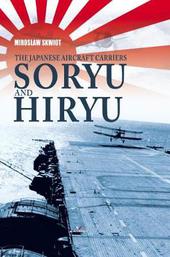
|
The Japanese Aircraft Carriers Soryu and Hiryu
Hardback
Main Details
| Title |
The Japanese Aircraft Carriers Soryu and Hiryu
|
| Authors and Contributors |
By (author) Miroslaw Skwiot
|
| Series | Hard Cover |
|---|
| Physical Properties |
|
| ISBN/Barcode |
9788364596520
|
| Audience | | Professional & Vocational | |
|---|
| Illustrations |
82 archive photos* 30 drawings* 16 Colour profiles* 1 map
|
|
Publishing Details |
| Publisher |
Kagero Oficyna Wydawnicza
|
| Imprint |
Kagero Oficyna Wydawnicza
|
| Publication Date |
31 August 2015 |
| Publication Country |
Poland
|
Description
Soryu meaning "Blue (or Green) Dragon") was an aircraft carrier built for the Imperial Japanese Navy (IJN) during the mid-1930s. A sister ship, Hiryu, was intended to follow Soryu, but Hiryu? 's design was heavily modified and she is often considered to be a separate class. Their aircraft supported the Japanese invasion of French Indochina in mid-1940. During the first month of the Pacific War, they took part in the attack on Pearl Harbor and the Battle of Wake Island and then supported the conquest of the Dutch East Indies in January 1942. The following month, their aircraft bombed Darwin, Australia, and continued to assist in the Dutch East Indies campaign. In April, Hiryu's aircraft helped sink two British heavy cruisers and several merchant ships during the Indian Ocean raid. Hiryu was the second aircraft carrier included in "The Second Naval Armaments Supplement Program" of 1934. Originally both carriers were supposed to be sister vessels, but the number of design modifications introduced during the construction of Soryu resulted in many differences between the two. According to the original plans Hiryu was to be completed a year after Soryu, but her construction (similarly to her predecessor) suffered delays caused by two key factors. The first one was the implementation of the lessons learned during the reconstruction of Kaga, which was going on simultaneously with Hiryu's construction. Then there was new data available from the early service days of Soryu, which exposed some of the design's drawbacks and weaknesses. The number of issues popping up "along the way" was further increased by the Fourth Fleet Incident and by Japan's withdrawal from the previously signed naval treaties. Considering all those issues, it is not hard to imagine the inevitable impact they had on Hiryu's original design and construction schedule. The greatest source of delays was undoubtedly the aftermath of the Fourth Fleet Incident, which forced the Navy Aviation Bureau to introduce changes in the design of the second carrier. After the new requirements had been implemented, Hiryu's final design (known as the "Basic Project G-10") finally emerged.
ReviewsA hard cover book from Kagero this time, with the history of the development and service history of two of the famous Japanese aircraft carriers of WW2, both of which took part in the raid on Pearl Harbour in December 1941. Essentially sister ships, they did turn out to have some differences by the time both were completed. I found it interesting to read about their development in the context of the pre-war period, when the limitations of the Washington Treaty on warships had an effect on warship design, and when the very creation of full deck aircraft carriers was still in its' infancy. Experience with operating earlier carriers (Akagi and Kaga in particular) as well as lessons learnt from vulnerability to a variety of ships when caught in very bad storms led to changes in building both Soryu and Hiryu. Soryu was slightly delayed in completion and Hiryu by as much as 2 years, though both were in service by the outbreak of WW2. On top of the development story and details of the design, the aircraft they flew and even diagrams of how aircraft were to be stowed in the hanger. Well illustrated throughout with archive photos this goes on to tell the operational stories of both vessels, both of which ended in their sinking. Filling 100 pages the story ends with the sinking of both carriers at the Battle of Midway in 1942, where they in turn had managed to sink one of the US carriers, the Yorktown. -- Robin Buckland Military Model Scene
|